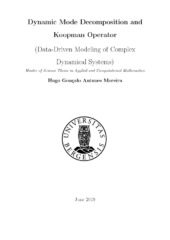Dynamic Mode Decomposition and Koopman Operator (Data-Driven Modeling of Complex Dynamical Systems)
Master thesis
Permanent lenke
https://hdl.handle.net/1956/20227Utgivelsesdato
2019-06-19Metadata
Vis full innførselSamlinger
- Master theses [130]
Sammendrag
Data-driven schemes are in high demand, given the growing abundance and accessibility to large amounts of measurements from historical records, numerical simulations, and experimental data. However, despite the abundance of data, modeling high-dimensional complex dynamical systems remains a challenge. In this thesis we present a data-driven method for modeling dynamical systems called the Dynamic Mode Decomposition (DMD). This is a recent method that has first emerged in the fluid mechanics community as a tool for analyzing the dynamics of nonlinear systems. However, given its ability to provide an accurate decomposition of a complex system into spatiotemporal coherent structures, it gained popularity and interest from other fields where complex nonlinear processes cannot be accurately characterized by known governing equations, or that exhibit a rich multiscale dynamic properties. This method relies on the fact that many of these systems evolve on a low-dimensional attractor that may be characterized by dominant spatiotemporal coherent structures. The confidence that the DMD is useful to characterize non-linear dynamics is given by theoretical framework provided by Koopmans theory, which will also be presented in the thesis. Short examples are used to illustrate the DMD application and the Koopmans operator theory. Finally, two data-sets generated from two different fields (from a 2D ocean model, and a neuron strip experiment) are tested using the DMD. We will use the decomposition results to identify structures which we may relate to a physical phenomena, and discuss the performance.
